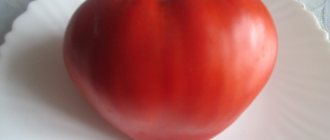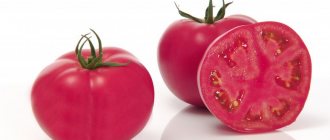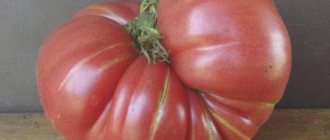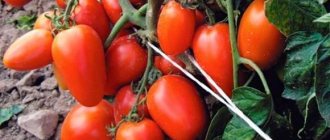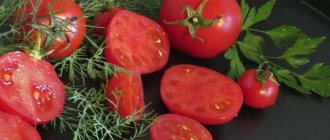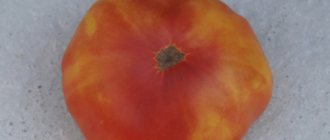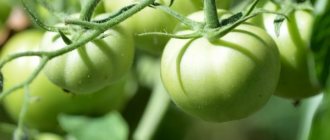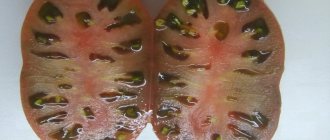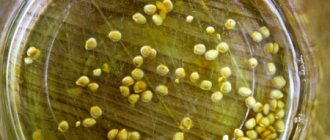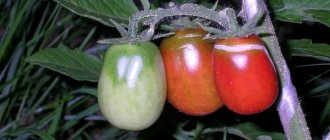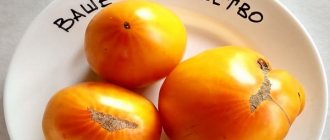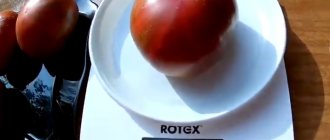Despite a certain amount of prejudice against hybrids, they are confidently gaining space in gardens. Tomato Jaguar F1 is one of these high-quality, productive and early hybrid varieties, the taste of which pleases many summer residents.
| Height | Landing location | Ripening time | Fruit color | Fruit size | Origin | Fruit shape |
| Tall | Greenhouse, Open ground | Early ripening | Reds | Average | Hybrid | Round |
"Zelenushka F1"
The name of this hybrid, most likely, was not very attractive to the packer and it was renamed the “Green Sweet Tomato” tomato.
The hybrid was entered into the register in 2007, and its originator is Selection and Seed Agro Moscow Region LLC. Mytishchi.
The hybrid is recommended for cultivation in the Northern, Central, Northwestern, Volga-Vyatka, Central Black Earth, North Caucasus and Middle Volga regions.
The tomato is intended for greenhouses and light film shelters for vegetable growers' private farms.
Once planted in a greenhouse, already on day 115 you will be able to taste the harvest. The plant is determinate, and the leaf blade is recognizable; it is unusually wide, short-truncated and light green in color.
The fruit is round, dense, one might even say hard, with a smooth, pleasant skin. During the period of growth and technical maturity, it is green with a bright, rich, dark green spot at the stalk. Ripening, dark greens dissolve, and the tomato acquires light amber shades. At the stage of biological maturity, the fruits are emerald-amber in color.
The fruit has 2 seed nests, and the average weight does not exceed 12 g.
Tomatoes have excellent taste. Having an interesting color, they resemble large gooseberries, which attracts children to the bushes.
The commercial output of a tomato is within 4 kg, but the high commercial yield, compactness on the hand and excellent keeping quality put the hybrid in the first line of desirable tomatoes.
The hybrid is very disease resistant. Tobacco mosaic virus, cladosporiosis, and fusarium never affect the hybrid.
Advantages:
- excellent taste;
- interesting color;
- excellent keeping quality;
- good product yield;
- high transportability.
Growing tomato seedlings
Hybrid seeds, processed using special technology and painted in a bright color, do not require pre-sowing soaking or dressing. They are sown immediately in prepared soil.
You can use peat-sand compost. You can take ordinary soil from the garden or vegetable garden (but not from the area where nightshades grew last year), mix it with half the volume of sawdust. Add wood ash (half a liter jar to a bucket of soil). It’s good to add superphosphate (3-4 tablespoons). Drainage is required.
If seedlings are grown indoors, use low boxes. Prepared soil is poured onto the drainage layer, grooves are made in it, and seeds are sown in them. Lightly crush with earth and compact so that the seeds, when germinating, do not lift the soil layer.
Tips for caring for seedlings:
- The box with the sown seeds is covered with glass or plastic film and placed in a warm place. Every day they ventilate and see if the soil is dry. If necessary, water with warm water.
Good lighting is not necessary at this stage. But as soon as the seeds have hatched and sprouted, the box with seedlings should be placed in the brightest place. This usually happens on the 5th day.
The room temperature should be lowered to 12-15°C, and at night to 8°C. This will prevent the seedlings from stretching, which often occurs in low light and high temperatures. In addition, she will be hardened. After a week, when the seedlings have become stronger, they can be grown at a temperature of 18-20°C. At night it should be lower, about 10°C. After the seedlings have formed a second true leaf, they are planted in separate dishes, plastic or even glass glasses. You can use peat briquettes. If you run out of individual dishes, you can plant the remaining seedlings into deep boxes at a distance of about 5 cm from each other. You can use plastic ones from under vegetables, cover the bottom and walls with newspapers. The soil will not be able to fall out of such a box, and excess moisture will easily drain away through the paper. This form of planting is convenient because it is easy and convenient to take them out into the fresh air for hardening. Usually, when diving, part of the seedling's root is torn off. If this does not happen, you need to pinch it off manually. This will contribute to the formation of a powerful root system. When planting in cups, the soil is not poured to the top. About 4 cm is left in order to add soil as the plants grow. This is done once every 10 days. If there are a lot of seedlings, plant 2 plants in each pot. When it becomes clear which of them is stronger, the second copy is torn off at soil level. Feeding is carried out once every 10 days. Nitrogen fertilizers will make seedlings grow faster. This is not always appropriate. Such fertilizers are used only when seedlings for some reason are stunted in growth. But young tomatoes need phosphorus fertilizers. You can put a couple of nitrophoska grains in each pot. Then add soil and water the plant. For fungal diseases, a few days before planting, they are shed with a pink solution of potassium permanganate.
Description of the Jaguar tomato and rules for growing seedlings
Experienced vegetable growers give their preference to high-quality varieties of nightshades with strong immunity, which give an excellent harvest. The Jaguar tomato is a Dutch hybrid that belongs to these varieties.
It gives an early harvest and is suitable for growing in greenhouse conditions and in open ground. Tomatoes of this variety have good taste. They are used universally.
Tomatoes are suitable for making juice, paste, lecho, ketchup and for creating vegetable salads.
Growing the Jaguar tomato variety is not difficult. The culture is unpretentious and easily tolerates temperature changes and short-term drought. Even a beginner can cope with care. The main thing is to competently organize the process of growing seedlings, planting in the ground and further care. To do this, it is worth studying the characteristics and recommendations given by the tomato manufacturer Jaguar F1.
General characteristics of the variety
The tomato variety Jaguar is an indeterminate species. The bush has a powerful root system that goes more than 1 m deep. A tall and powerful plant needs additional support and pinching. Gardeners recommend forming a bush with 1-2 stems.
For all its power, it has a compact and neat appearance. The branches are not very spreading, the foliage moderately fills the plant. It is dark green in color and has a normal shape. This type of tomato loves warmth and light, but has established itself on the market as a cold-resistant plant.
The fruits have a round shape with mild ribbing, bright red in color with a smooth and shiny skin. The average weight of one tomato reaches 160-180 g. There are no more than 4-6 nests on a branch.
The taste of this tomato is excellent, the flesh is dense and juicy, contains light acidity and spicy notes. The moment of ripening of the first fruits can be expected 75-80 days after the first shoots of seedlings. The productivity of Jaguar tomatoes is high. On average, from 7 to 10 kg are collected from 1 m². In greenhouse conditions, the fruits can have greater weight, and the plant reaches up to 1.5-2 m in height.
The harvest can be stored for a long time, about a month. The main thing is to correctly create all the conditions for this. The dense peel protects the tomatoes from cracking and makes them suitable for long-distance transportation.
Many vegetable growers recommend using beds for planting tomatoes that previously grew cucumbers, cauliflower, zucchini, carrots, onions, dill or parsley.
Growing seedlings
Sowing seeds for seedlings should be done in March. On the package of seeds, as a rule, the manufacturer indicates a schedule for planting seedlings and the timing of planting them in open ground. Before sowing, many gardeners prepare the seeds in a certain way.
In order to increase the plant's resistance to fungi and pests, the seeds are immersed in a manganese solution for 30 minutes. Then let it dry thoroughly. And to activate growth, you can soak them in a growth stimulator. After processing the seeds, it is worth preparing the soil and container for sowing.
The soil can be purchased ready-made in specialized stores or prepared independently as follows: 1 part of turf soil is mixed with 1 part of peat and sand. The soil needs to be slightly moistened and placed in a special container.
Young shoots will break through to the surface in 10-14 days, and if the conditions are suitable, they will quickly gain strength and get stronger. As soon as the first 2 leaves appear on the plants, they can be transplanted into separate pots. The picking should be done directly into peat cups. This will allow you not to disturb the roots of the young plant when planting in the beds in the future.
Seedlings are planted in open ground as soon as the weather becomes warm outside and the ground warms up.
The soil in the beds must initially be fertilized; for this you can use humus or special mineral complexes.
Planting material is planted according to a 50 by 40 pattern, with 6 to 9 bushes placed per 1 m². The beds should be watered with settled water immediately after planting and mulched. For mulch, it is best to use regular wood sawdust.
Further care for tomatoes is as follows:
- regular morning watering;
- loosening and weeding beds;
- application of mineral fertilizers;
- stepsoning.
Reviews about the Jaguar variety are most positive. The tomato has a good taste, high yield and is not a hassle to grow. It has good resistance to many diseases.
Description and characteristics of the variety
Jaguar F1 tomatoes have indeterminate bushes with a height of 1.6 m. Their roots are powerful, the stems are strong, covered with an average number of leaves. The fruits grow in small clusters of up to 5 pieces each. The weight of one tomato is up to 180 g, they are round, red, with smooth shiny skin, smooth and in excellent presentation. There is some ribbing.
The pulp is fleshy, juicy, without wateriness, dense and does not crack. Has a pronounced aroma. Tomatoes are suitable for canning and pickling, fresh consumption, preparing stews, soups, other dishes, juices and pastes.
Planting and care
A window sill or balcony is poorly suited for growing tomatoes - the plants suffer from insufficient watering, overheating and stuffy air. To increase the immunity of tomatoes, stimulants are used. They give adult plants resistance to unfavorable climates.
Epin can also be used during the growing season. They spray the seedlings one day before transplanting or picking.
Many people do not know how to sow tomatoes if they are supposed to be grown on a balcony or windowsill. The main thing is to prepare the soil mixture correctly. Store-bought soil for tomatoes is poured into the pot.
If you need to prepare the soil yourself, mix:
- land from dacha 3;
- humus 1;
- wood ash 0.1.
Add a tablespoon of urea and the same amount of potassium salt to a bucket of the mixture. Fine expanded clay or crushed stone is poured into the bottom of the pot, then soil.
Description of the Pablo tomato variety, yield and cultivation
Tomato lovers will appreciate the fruit of modern selection - the Pablo f1 tomato. Numerous advantages have ensured that the variety is in demand among gardeners in different regions of Russia. The originator of the plant was the Japanese company Sakata, and today the new product was officially entered into the state register.
General information about tomato
The Pablo variety of tomato is suitable for growing in greenhouses and open beds. Description of the appearance and characteristics of the plant:
- early ripening, the period before harvest is 95 days;
- indeterminate, has unlimited growth;
- tall, reaches 2 meters;
- powerful root system;
- good foliage;
- slightly ribbed;
- average yield, over the summer they get up to 4 kg per 1 sq. meters of landing;
- the number of fruits in the cluster is 5-6 pieces;
- good adaptive abilities;
- ease of care;
- resistance to most diseases of the nightshade family;
- possibility of transportation over long distances without loss of presentation;
- keeping quality.
Tomatoes have become a novelty among hybrid varieties. The ability to bear fruit in unfavorable weather conditions and poor soils has made it possible to grow tomatoes in all regions of Russia. Technical data and appearance of the fruit:
- flat-round, leveled shape;
- dense;
- thin skin;
- large, average weight 200 grams;
- red color when ripe;
- sweet taste;
- fleshy, not watery;
- fragrant.
Recommendations for cultivation
The plant prefers the seedling method of planting. Preparatory work begins 2 months before the expected planting date. When preparing seedlings, it is recommended:
- sow seeds to a depth of 1-1.5 cm;
- after planting, cover the containers with film;
- maintain temperature 21-25 degrees;
- after the sprouts appear, remove the film, transplant the tomatoes into separate pots and move them to the light;
- regular watering;
- picking.
IMPORTANT! Before planting, seedlings should be hardened off. For 1 sq.
Place no more than four tomatoes per meter of land according to a 40 x 60 cm pattern. The plant is undemanding; mandatory care measures include:
For 1 sq. Place no more than four tomatoes per meter of land according to a 40 x 60 cm pattern. The plant is undemanding; mandatory care measures include:
- watering with water not lower than the air temperature;
- feeding with complex mineral fertilizer, at least 4 times during the summer period;
- regular loosening and weeding of the soil;
- pinching, forming a bush into one stem;
- installation of supports and tying to the trellis with synthetic materials.
Gardeners' opinion
Good afternoon. I've heard positive reviews about Pablo's tomato. This summer I tried to grow it and was pleased.
The tomato bore fruit in the cold summer, withstood all unfavorable conditions, and had good yields. Suitable for cultivation in the northern regions of Russia. There were no difficulties in care. In greenhouse conditions I received 3 kilograms of berries from 1 sq. meters of landing. I recommend!
Valerian Egorovich, 54 years old.
Good afternoon! I recommend the Pablo variety to all tomato lovers. It tolerates heat well and does not require close attention. Suitable for growing in open ground in the southern regions of Russia. Ripe berries are suitable for salads, twists and pickles.
General information about the variety
This new hybrid variety is available for cultivation in protected and open ground conditions.
This heat-loving plant of Dutch origin is distinguished by:
- Early ripening, the first berries begin to be picked after 85–95 days.
- Hybrid.
- Indeterminate.
- Compact.
- The number of ovaries on one hand does not exceed five.
- Self-pollinating.
- Tall.
- Average foliage of bushes.
- Powerful root system.
- The foliage has a characteristic green color.
- Stress resistance.
- High growth vigor.
- Stable immunity to many fungal and viral diseases: verticillium and fusarium, tobacco mosaic virus, nematode.
- High yields, up to 4.5 kilograms of berries are obtained from one bush.
- Long fruiting period.
- High safety rate.
- Transportation is possible without loss of presentation.
- Requires regular pruning.
- Unpretentious to soil composition.
- Low temperature resistance.
Jaguar f1 is cultivated by Russian, Moldavian and Ukrainian vegetable growers. Technical data and external features of the fruit:
- Round shape.
- High density.
- The thin skin is red when ripe.
- Not prone to cracking.
- The maximum weight does not exceed 180 grams.
- Slight ribbing.
- Good taste.
- Suitable for early harvest and ripening at home.
- Persistent tomato aroma.
- Fleshy.
- Not watery.
Tomato fruits are used for twists, pickling and fresh consumption. The variety has a universal purpose.
Characteristics and description of the Ural tomato
Many summer residents will like the excellent varietal qualities that are inherent in the Ural.
Description
The variety belongs to the mid-season varieties; approximately 116-120 days pass from germination to fruit ripening. The bush is indeterminate, grows from 150 to 180 centimeters. The stem is quite strong, medium leafy, the inflorescence is simple, 3-4 fruits are formed on one. The foliage is large, dark green. The fruits are flat-round in shape, smooth, and at the ripe stage are bright red. The tomatoes are quite large, 200-350 grams. But there may be more on the lower hand. Their skin is dense, the flesh is fleshy, and has an excellent taste. With the prescribed care, you can get up to 5 kg of juicy ripe tomatoes from one bush, which is not bad.
This variety was created specifically for the Urals, but it can be planted throughout Russia. It is recommended to grow plants in greenhouse conditions. Tomatoes can be eaten fresh, added to various dishes, and can also be preserved for the winter, in the form of juice, salads, lecho and sauces.
Diseases and prevention
It has excellent resistance to common diseases, such as tobacco mosaic virus, but it cannot be treated and can cause significant damage to fruits. And also to fusarium and cladosporiosis. The fruits are also resistant to cracking and can be stored and transported for a long time, while maintaining an attractive appearance. But, unfortunately, there is no variety yet that is 100% resistant to late blight, so it is necessary to prevent the disease; it is much easier than treating it later.
Weather resistance
The variety tolerates temperature changes well, because it is adapted to the Ural climate, where cold snaps are not uncommon. Fruits on the bushes will be actively set even in cool and cloudy weather. “Ural” also endures overheating.
Advantages
- Large beautiful fruits.
- Great taste.
- Natural immunity to many diseases.
- Can be stored and transported.
- High yield.
- Uniform ripening.
Flaws
- It is necessary to tie the bushes to the support and remove the stepsons.
- Productivity greatly depends on growing conditions and care.
Agricultural technology
As stated above, this variety requires regular care; this will guarantee high yields. To plant seeds for seedlings you will need:
- Convenient container.
- Viable seeds purchased from trusted suppliers.
- Fertile soil for seedlings.
Soil is poured into the container, slightly moistened and grooves 15 mm deep are made in it, seeds are sown in them, at a distance of 2 cm. You should not reduce it, this will thicken the planting and the seedlings may stretch out. A comfortable temperature for seedlings is 18-22 degrees, the room should be well lit, it is better to place containers with seedlings on the windowsill. In the evening, it is recommended to illuminate young plants with a lamp.
Seedlings are planted in separate containers when one leaf appears. In order for it to develop faster and grow stronger, it can be fed using specialized complex fertilizers for seedlings. The optimal age for transplanting it is 55 days; if the seedlings have not reached this age or are much older, you may not get the expected result. Before planting, hardening must be carried out for 7 days.
Transfer
It is better to choose a bright place for tomatoes; they love light and fertile soil; if its acidity is high, it is extinguished with lime; it is advisable to do this in the fall. The recommended planting pattern is 60 by 40; wood ash is added to the holes before planting. Since the bushes are tall, they need support, for this you can use stakes or install a trellis. You also need to remove the shoots weekly, forming plants into 1-2 stems. Approximately in the middle of the growing season, the leaves from below are removed, this will speed up the ripening of the fruit.
Like all Ural tomatoes, you need to water them regularly, but sparingly, without getting them on the leaves, after which the greenhouse should be well ventilated. Weeds are removed as they appear; row spacing must be loosened every 10-12 days. Some experienced gardeners advise mulching the soil with sawdust or grass clippings. Feeding tomatoes is also important; it should be done every two weeks, alternating organic and mineral fertilizers.
Conclusion
Not such a large number of worthy varieties have been bred for areas with variable climates and cool summers, especially those that are more resistant to diseases and have consistently high yields. “Ural” will be a godsend for residents of the southern regions, because it has a lot of positive qualities.
Tomato skif reviews
This new hybrid variety is available for cultivation in protected and open ground conditions.
This heat-loving plant of Dutch origin is distinguished by:
- Early ripening, the first berries begin to be picked after 85–95 days.
- Hybrid.
- Indeterminate.
- Compact.
- The number of ovaries on one hand does not exceed five.
- Self-pollinating.
- Tall.
- Average foliage of bushes.
- Powerful root system.
- The foliage has a characteristic green color.
- Stress resistance.
- High growth vigor.
- Stable immunity to many fungal and viral diseases: verticillium and fusarium, tobacco mosaic virus, nematode.
- High yields, up to 4.5 kilograms of berries are obtained from one bush.
- Long fruiting period.
- High safety rate.
- Transportation is possible without loss of presentation.
- Requires regular pruning.
- Unpretentious to soil composition.
- Low temperature resistance.
Jaguar f1 is cultivated by Russian, Moldavian and Ukrainian vegetable growers. Technical data and external features of the fruit:
- Round shape.
- High density.
- The thin skin is red when ripe.
- Not prone to cracking.
- The maximum weight does not exceed 180 grams.
- Slight ribbing.
- Good taste.
- Suitable for early harvest and ripening at home.
- Persistent tomato aroma.
- Fleshy.
- Not watery.
Tomato fruits are used for twists, pickling and fresh consumption. The variety has a universal purpose.
What is a Shakira tomato?
Characteristics and description of the variety:
- The tomato is mid-early.
- The plant is indeterminate.
- The bushes grow up to 1.5 m in height.
- If you do not pinch the stem, the plant can grow up to 2 m.
- Bushes need to be tied to support pegs or trellises.
- Tomatoes can be grown both in greenhouse conditions and in an open garden.
- The fruits have an excellent sweet and sour taste.
- The shape of the tomatoes is flat-round.
- The skin is dense and does not crack.
- The harvest ripens in 110-115 days.
The main feature of tomatoes is their resistance to diseases such as tobacco mosaic, cladosporiosis, fusarium. Sometimes tomatoes can get late blight. To avoid disease, you need to spray the plants with disinfectant compounds.
Tomato leaves are bright green in color. The root system of plants is well developed. The fruits ripen on clusters, 5-6 tomatoes on each. The fruits are large, one tomato weighs 250-300 g. Ripe fruits have a bright red color. Shakira tomatoes are used fresh, for salads, side dishes, tomato paste and puree, juices, and hot dishes. The fruits of this variety can be salted and pickled.
How are tomatoes grown?
Seeds are planted in early March. You must first prepare containers for planting. They are filled with special soil for seedlings of peppers and tomatoes. The soil is poured into containers 10-12 cm deep.
Then furrows are made for sowing. The seeds do not need to be soaked or treated with potassium permanganate. They are carefully buried in the soil in prepared furrows every 2 cm.
After sowing, sprinkle with soil 1-1.5 cm thick.
Then you need to water the soil with warm water, cover it with cellophane, and place the container with the seedlings in a warm room. Sprouts will form in 5-7 days and will begin to emerge to the surface.
After the shoots appear, the cellophane is removed, the container with the sprouts is placed in a bright place, perhaps on a windowsill. When 2 leaves appear on the shoots, pick. They are planted in peat pots. If there is little sunlight, then you need to turn on fluorescent lamps.
At the beginning of May, when warm weather sets in, the sprouts are transplanted into a greenhouse. After transplanting the plants into the ground, it is necessary to water and loosen the soil. If the seedlings are large, you can immediately install trellises and secure the plants.
When growing tomatoes, they need to be hilled in order for a good root system to form. The first time this is done on the 10th day, the second time on the 20th day.
To increase productivity, bushes are formed into 2 stems. Stepchildren must be removed regularly. When growing tomatoes, they need to be watered periodically, weeded, and loosened. Watering is increased when the first and second ovaries begin to bloom. Twice a month, tomatoes are fertilized with complex compounds.
Reviews from gardeners about the Shakira variety are mostly positive. People note excellent yield, wonderful taste, resistance to diseases. The plant is unpretentious and does not require too much care. Tomatoes have very beautiful large fruits.
Growing seedlings
Seedlings are sown in the first ten days of March. To do this, prepare containers with soil intended for growing tomato and pepper seedlings. Soil is poured, about 10-12 cm high, and grooves are drawn.
Seeds of the Shakira F1 variety can not be soaked and treated with potassium permanganate, but carefully laid out on the grooves every 2 cm, covered with soil one to one and a half centimeters. Lightly water with melt water, cover with film, and place in a warm place for germination. After 5-7 days, shoots will begin to appear.
The film must be removed and the box with seedlings placed on the windowsill, closer to the light. After 2 true leaves appear, it is recommended to pick the plants. Tomatoes should be planted in separate pots. If there is not enough light, it is advisable to illuminate it with a lamp.
When more favorable conditions arrive (around the beginning of May), the seedlings are planted in greenhouses. After planting, it is recommended to water and loosen the soil well. If the seedlings are developed and tall, then it is recommended to immediately attach a trellis near each plant.
Useful tips
During plant growth, it is recommended to hill them to form an additional root system. The first time is approximately on the 10th day of disembarkation, and the second time is on the 18-20th day.
In order for tomatoes to produce a good harvest, it is recommended to form 2 stems from them. It is imperative to monitor the growth of stepchildren, which must be periodically removed.
During the entire growing season, it is recommended to remove weeds, loosen and water the plants. Watering is most active when the first and then the second flower clusters grow and bloom.
Don’t forget to feed it 2 times a month with complex fertilizers.
Shakira tomato varieties have only positive reviews. Everyone who grew it was satisfied, noting the high yield, excellent taste, and resistance to disease. Tomatoes do not require special care; the fruits are large and hang beautifully on the cluster.
Technical data of the plant and its fruits
The characteristics and description of this tomato are as follows:
- The variety allows you to get a harvest in the middle growing season. From planting the seed fund to receiving the first fruits, it takes from 112 to 115 days.
- The height of the plant bush reaches 0.65-0.75 m. A large number of leaves, painted in light green tones, grow on the stems. They have a round shape, slightly different from the standard proportions of tomato leaves.
- The hybrid is resistant to diseases such as Fusarium and Verticillium wilt and viral curl. The plant is resistant to garden pests such as nematodes.
- Tomato fruits have the shape of a spheroid flattened at the top and bottom. The ribs are visible on it.
- The weight of the fruit ranges from 0.18 to 0.22 kg. They are painted in bright shades of pink. The taste of the berries is delicate and pleasant. Inside the fruit there are 3-4 seed chambers. The peel has medium density.
Feedback from farmers shows that the yield of tomatoes of this variety can range from 15 to 18 kg of fruit per 1 m². The fruits do not crack during long-term storage or transportation. They are usually used for salads or eaten fresh.
In Russian conditions, it is recommended to grow the hybrid in open ground or in greenhouses without heating in the southern regions and in the open spaces of the middle zone. In Siberia and the Far North, the hybrid is grown in well-heated greenhouse blocks.
How to grow a hybrid in your garden
The described variety is grown from seeds. They are purchased in special branded stores. To increase plant immunity and eliminate the risk of fungal diseases on tomatoes, the entire seed fund is treated with potassium permanganate. Seeds are planted for seedlings 55-65 days before the planned planting of seedlings in the beds.
The soil is prepared in the fall. To do this, dry stems and branches of lupine are introduced into it. If it is not there, then you can use humus. The hybrid must be planted in the soil where carrots, eggplants or dill grew. Seeds planted in beds are watered with water at room temperature.
When 1-2 leaves appear on the sprouts, you need to pick. After this, the bushes are fed with mineral fertilizers (superphosphate). Then the sprouts are hardened and ventilated to increase the hybrid’s resistance to external conditions.
After transferring the seedlings to permanent soil, they are again fed with complex fertilizers. For every 1 m² of bed area, you can plant from 4 to 6 bushes. During the entire period of plant growth, the appearance of ovaries and fruits, it must be fed with fertilizers 2 times.
Watering the bushes is carried out with warm water. It is advisable to do this after sunset or early in the morning, when the sun has not yet risen. It is poured under the roots of the plant, but it is recommended to avoid washing out the hole or getting moisture on the leaves of the hybrid. It is necessary to hill up the bushes in a timely manner, remove weeds, and eliminate stepchildren.
When garden pests appear, for example, various caterpillars, aphids, and the Colorado potato beetle, it is recommended to use chemical agents that kill insects and their larvae to destroy them. If a disease develops to which the hybrid is not resistant, it is recommended to use special medications by spraying the leaves of the hybrid with them.
Source: https://eko4.ru/tomat-skif-otzyvy/
Description of the variety
The bushes begin to bear fruit 85-95 days after the first shoots appear. Tall plants are compact. The fruits are set in clusters. Up to 5 fruits are formed in one brush.
The shape of the vegetables is round, the flesh is dense and juicy. The average weight of one fruit does not exceed 180 grams. The skin is thin but durable. When ripe, tomatoes acquire a rich red color. There is a slight ribbing near the stalk.
The taste of the fruit is excellent. During heat treatment and long-term storage, the skin does not crack. This makes tomatoes suitable for long-distance transportation.
Tomatoes of the Jaguar variety can be picked from the bushes in milky ripeness, and they ripen at room temperature. Fleshy fruits are often used to prepare vegetable salads and for slicing.
Tomatoes are also suitable for all types of preparations.
Features of cultivation
Hybrid varieties do not require self-collection of seeds. They should only be purchased in a specialized store. Therefore, no additional processing is necessary. The soil can be purchased ready-made, or you can prepare it yourself. To do this, garden soil is mixed with peat, you can add sand or manure.
Soil is poured into the prepared container and the seeds are planted to a depth of 1-1.5 cm. There is no need to water the crops, just lightly moisten them by spraying. The container with plantings should be covered with polyethylene or glass and put in a warm place. The air temperature should be +21-+23 degrees. When sprouts appear and 2-3 true leaves develop, the plants need to be pruned.
Both plastic glasses and special peat containers are well suited for this.
Planting in the ground is carried out after hardening the seedlings. For 7-10 days, the seedlings are taken outside every day, gradually increasing the time spent in the fresh air. The distance between the holes should be 50 cm.
Between the rows you need to leave about 40 cm. The soil is fertilized in the fall by adding humus. If fertilizing was not applied in the fall, then this must be done before planting. There are 6 seedlings per square meter.
From one kut you can harvest 4.5 kg of ripe tomatoes.
Care instructions
Experienced gardeners advise forming plants into 1-2 shoots. If grown in a greenhouse, the bushes can reach 2 meters, in open ground - up to 1.5 meters.
To ensure that the fruits do not fall to the ground and there is no risk of the stem breaking under the weight of the tomatoes, the bushes must be tied to installed crossbars or trellises.
It is recommended to tear off the stepsons and lower leaves in a timely manner.
Regular loosening of the soil will help normalize the supply of oxygen to the roots. It must be carried out carefully so as not to damage the root system. Weeding and hilling are also required.
Plants should be watered moderately. There is no need to allow waterlogging. Unpretentious bushes tolerate drought well, but to achieve better results in harvesting, it is advisable to avoid this.
It is necessary to water once a week with warm, settled water.
It is imperative to apply complex mineral fertilizers several times a season. The additives should contain nitrogen-containing compounds, as well as phosphorus-potassium mixtures.
To prevent and control harmful insects, it is necessary to spray the bushes with insecticidal preparations. Every year it is recommended to change the place for planting tomatoes. The variety is quite resistant to tobacco mosaic, verticillium and fusarium.
Tomato bushes grow well after vegetable crops such as onions, cabbage, parsley, carrots and parsley.
Jaguar tomatoes grow well throughout our country. This makes them very popular among gardeners. All avid gardeners note the excellent taste of the variety, unpretentiousness in care and to the region of growth. A versatile vegetable suitable for preparing and eating fresh.
caring for tomatoes - the first important steps
Source: https://stroim21.ru/dacha/tomat-yaguar-%E2%80%94-opisanie-i-harakteristika-sorta.html
Rating of the best varieties of tomatoes for a polycarbonate greenhouse
Home » The best varieties » Rating of the best varieties of tomatoes for a polycarbonate greenhouse Growing and harvesting a rich harvest of delicious ripe tomatoes from your garden is the dream of any summer resident. This will require not only creating an optimal environment for this crop and providing the necessary care, but also making a choice of what to grow in your beds.
Today, a huge variety of cultivars have been bred, and it is very difficult to figure out which of them are more suitable for growing in greenhouse conditions.
In this article we will look at their types and determine the best varieties of tomatoes for polycarbonate greenhouses.
First of all, it is worth separating varietal and hybrid cultivars. The main feature of hybrids is that it is impossible to independently take seeds from grown plants in order to plant them next year. Varietal species, on the contrary, reproduce well by seeds.
Based on growth characteristics, two types are distinguished:
- determinant;
- indeterminate.
- Determinate plants, having grown to a certain size, stop growing. Typically these include low-growing species that are suitable for low greenhouses. For most, the fruits ripen early (90-110 days from sowing the seeds); as a rule, they do not require pinching.
- Indeterminate ones continue to grow throughout the entire fruiting period. Growth slows down only under the influence of worsening climatic conditions.
According to fruit ripening dates:
- Early ripening
- Mid-season
- Late
Each cultivar is characterized not only by the size of the bush and the timing of crop ripening, but also by the size, shape, and color of the fruit. Taste qualities, shelf life of ripe vegetables, plant resistance to disease and care features are important.
Reading with this article: Why there are no tomatoes in a polycarbonate greenhouse
In accordance with these characteristics, we have selected the best varieties of tomatoes for the greenhouse and now we will tell you about them in detail.
We invite you to familiarize yourself with the Fighter Buyan tomato variety
Characteristics and description of the tomato variety Pink Unicum F1, its yield
Having studied what the Pink Unicum f1 tomato is, many gardeners decided to grow this exotic fruit. The first thing that attracts everyone is the high productivity of the plant. An important factor is the properties of the fruits themselves. Having the correct shape and pleasant color, tomatoes have a good taste and texture. Next, the characteristics and description of the variety of this tomato will be given.
Description of tomato
Pink Unicum tomatoes were developed in the Netherlands. Initially, this crop was intended for mass industrial cultivation in large greenhouses with central heating. The F1 hybrid was based on high yields with minimal use of synthetic fertilizers. Later, after studying the description of the Unicum Pink variety, private individuals also became interested in it.
Cultivation of the plant was successfully carried out not only in the greenhouse, but also in the open space. At the same time, the ripened fruits turned out beautiful and appetizing. The taste qualities of the tomatoes were also assessed. Today this is one of the most delicious varieties of tomatoes that are grown commercially.
The main characteristics of the Pink F1 variety are as follows:
Productivity is high. The bush has a small number of leaves, the bulk of the nutrients go to the fruits. On 1 bush, 3-4 bunches of tomatoes ripen, 4-6 pcs. in each. With the right approach to plant care, its yield is up to 17 kg/m² of sown area. The taste is distinctly tomato-like. The fruits have a pleasant, somewhat spicy aroma. There are no hard fibers or voids in the tomato mass. The skin of the fruit is thin but durable. It does not break even under strong pressure. Thanks to this, Pink tomatoes tolerate transportation well. The fruits are round and geometrically regular in shape. Ripe tomatoes are scarlet in color with a pink tint. Tomatoes look great on the table either whole or cut into slices as part of a salad. The glossy skin makes the fruit especially attractive
Almost all buyers pay attention to Unicum tomatoes. The ripening period is average. As a rule, from the moment you start working with seeds until the first fruits appear, about 110-120 days pass
After this, the bushes bear fruit for several months, delighting gardeners with a generous harvest.
Tomato f1 Dobry: characteristics and description of the variety, yield with photos
First generation hybrids are bred to display the best parental qualities. Such is the Dobry tomato, obtained in the form of an indeterminate plant. It is especially suitable for growing under film covers.
Features of the hybrid
If you want to grow delicious tomatoes for summer salads, then the Dobry variety is perfect for this. The bushes of the plant are tall, reaching 160-180 centimeters.
Large dark green leaves on long stems. The hybrid bears smooth, dense fruits that are light green when unripe and red when ripe. The tomatoes are flat-round in shape, weighing up to 170 grams.
Tomatoes are one of the best in taste – sweet and meaty.
The collected fruits are used for preparing summer salads and canning in pieces. Tomatoes ripen 110-120 days after the first shoots appear.
The Dobry F1 tomato is suitable for growing indoors, as it does not have time to ripen outdoors. From ten to thirteen kilograms of juicy tomatoes are harvested from one square meter.
Belonging to the F1 generation, the hybrid is resistant to such dangerous tomato diseases as fusarium and viral mosaic.
The excellent characteristics of the vegetable plant contribute to the prevalence of the hybrid in gardeners' plots.
Rules for agricultural technology of tomatoes in greenhouses
The seedling method is a real opportunity to obtain high-quality Dobry tomatoes.
Preparing the greenhouse for planting tomatoes
Any greenhouse structure is prepared for planting vegetables in the fall. The main procedure is disinfection of the premises. Wooden buildings are fumigated with sulfur. To do this, a mixture of sulfur and kerosene is placed on iron sheets and set on fire. Aphids for four days, sulfur will protect plants from pathogenic fungi and pests.
In greenhouses with a metal frame, a bleach solution is used to spray the surfaces inside.
The soil in the room is replaced with a new one every five years. Be sure to disinfect the soil mixture with Bordeaux mixture before planting the vegetable.
Since tomatoes are heat-loving plants, the soil must be heated from the inside. A layer of sawdust ten centimeters thick is poured under it, then compost – twenty centimeters thick.
Transfer rules
Seedlings are planted in well-heated greenhouses at the end of April, under film coverings - until mid-May.
The procedure for planting vegetables in a greenhouse is as follows:
- Make holes in the soil 15 centimeters deep.
- The seedlings are watered half an hour before planting in closed ground, and the long roots of the plant are shortened.
- Place the seedlings in the ground up to the first leaf. The elongated seedlings are slightly tilted, covering part of the stem with soil.
- The soil is compacted around the stem, and the bushes are sprayed with Bordeaux mixture (100 grams of substance per 10 liters of water).
See also Characteristics and description of the tomato variety Zemlyak, its yield
For Dobry F1 tomatoes, a garter to pegs or a trellis is required.
Plant care
Vegetable growers know how important it is to properly care for tomatoes. The rules of care include:
- moderate watering;
- regular feeding every ten to fourteen days;
- ventilation of the greenhouse;
- maintaining the air temperature no higher than 25 degrees Celsius, and humidity up to seventy percent.
Those who have planted indeterminate types of tomatoes advise not to forget about the formation of the bush. When removing stepsons, one stem is left, in rare cases - two.
Gardeners' opinion about the Dobry tomato
The hybrid bears fruit well in greenhouse soil and produces good yields. The taste of the fruit is excellent. Everyone who has planted tomatoes of this variety notes their resistance to diseases.
In order for the fruits to ripen faster on the bushes, red tomatoes must be removed from the branches in time. By correctly applying care rules, you can get a good harvest of Dobry tomatoes in mid-summer.
Source: https://openfile.ru/dacha-i-sad/%D1%82%D0%BE%D0%BC%D0%B0%D1%82-f1-%D0%B4%D0%BE%D0% B1%D1%80%D1%8B%D0%B9-%D1%85%D0%B0%D1%80%D0%B0%D0%BA%D1%82%D0%B5%D1%80%D0%B8 %D1%81%D1%82%D0%B8%D0%BA%D0%B0-%D0%B8-%D0%BE%D0%BF%D0%B8%D1%81%D0%B0%D0%BD .html
Seed selection and preparation
Do not neglect the selection of seeds, because you want to grow a healthy fruit-bearing plant. Seeds are now sold in markets, stores and on the Internet. There are seeds that have already been treated with special stimulants and are disinfected from mold, bacteria and fungi. If the seeds are collected by hand, then you need to prepare them. Dissolve 1 gram of potassium permanganate powder in a glass of water at room temperature and soak the tomato seeds for an hour. Then wash and plant in the ground. You can start hardening now by taking the seeds out into a cool corridor for a while.
For tomatoes, a specialized soil for tomatoes or a universal one is suitable. Typically, such mixtures contain the necessary nitrogen, phosphorus, microelements, and the soil itself is loose and airy. You can prepare the soil yourself, but you need to start preparing it in the fall. Take soil from the garden, mix it with compost, some sand, peat and ash.
It’s good if you take the soil on which nightshade crops previously grew. Before planting, add superphosphate to the soil. The optimal ratio of parts will be: 1 part earth, 2 parts peat, 1 part sand, 1 part humus. But keep in mind that peat increases the acidity of the soil, so be sure to add some ash.
General characteristics of the tomato Funtik f1 and description of the fruits of the hybrid variety
Many gardeners organize tomato yield competitions.
If a summer resident wants to surprise his neighbors, he should pay attention to the Funtik f1 tomato. These are large tomatoes that give a very good harvest
Their taste is simply excellent. Despite the fact that tomatoes are quite large, they have a universal purpose and are suitable for various uses. But still, Funtik tomatoes have gained the greatest popularity as an ingredient in salad. Their delicate sweet taste makes them an ideal addition to summer vegetable appetizers.
Funtik is a hybrid, so only original seeds purchased from the manufacturer should be used for cultivation. In this case, you can get ideal fruits with good weight and excellent taste. The Funtik variety was specially bred by Russian specialists. It has universal characteristics, so it is suitable for both open ground and greenhouses. The yield will be high in any case.
Description of the variety
This hybrid is classified as an indeterminate type. This suggests that the plant can have unlimited growth, so it should be pinched at the top. It is advisable to do this when the tomato reaches the 2 meter mark.
If you do not carry out the pinching procedure, the plant can stretch above 2.5 meters. In greenhouse conditions, the tomato can be even larger. But this has a bad effect on yield, since the tomato gives a lot of energy to the greens instead of saturating the fruits.
The plant grows very tall, but not too spreading, so the planting pattern for the bushes can be quite dense. You can place 6 tomatoes per 1 m².
Hybrid Funtik produces a large number of fruits. They are formed on brushes, of which there can be up to 12 pieces on each bush. There are 6 large tomatoes in one bunch.
The big advantage is that the plant produces all its fruits at once. This is convenient for those who grow tomatoes for canning. The productivity of the Funtik hybrid is very high. With proper agricultural technology, gardeners harvest up to 10 kg of delicious tomatoes from each bush.
The highest yield is observed with proper care of tomatoes. They must be well fertilized, weeded and moderately watered. As for spraying against diseases, it will not be superfluous for preventive purposes. But the manufacturer assures that this hybrid is highly resistant to late blight, verticillium and tobacco mosaic.
General characteristics of the variety
The tomato variety Jaguar is an indeterminate species. The bush has a powerful root system that goes more than 1 m deep. A tall and powerful plant needs additional support and pinching. Gardeners recommend forming a bush with 1-2 stems. For all its power, it has a compact and neat appearance. The branches are not very spreading, the foliage moderately fills the plant. It is dark green in color and has a normal shape. This type of tomato loves warmth and light, but has established itself on the market as a cold-resistant plant.
The fruits have a round shape with mild ribbing, bright red in color with a smooth and shiny skin. The average weight of one tomato reaches 160-180 g. There are no more than 4-6 nests on a branch.
The taste of this tomato is excellent, the flesh is dense and juicy, contains light acidity and spicy notes. The moment of ripening of the first fruits can be expected 75-80 days after the first shoots of seedlings. The productivity of Jaguar tomatoes is high. On average, from 7 to 10 kg are collected from 1 m². In greenhouse conditions, the fruits can have greater weight, and the plant reaches up to 1.5-2 m in height.
The harvest can be stored for a long time, about a month. The main thing is to correctly create all the conditions for this. The dense peel protects the tomatoes from cracking and makes them suitable for long-distance transportation.
See also
Description of the Prune tomato, growing in a greenhouse and in open ground
Read
The tomato variety Jaguar F1 is resistant to many diseases and has good immunity to tobacco mosaic, verticillium wilt and fusarium wilt.
Many vegetable growers recommend using beds for planting tomatoes that previously grew cucumbers, cauliflower, zucchini, carrots, onions, dill or parsley.
